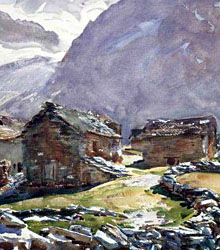
Simplon Pass is a pass over the Alps. Not known early save as a purely local route, the Simplon Pass rose into importance when Napoleon caused the carriage road to be built across it between 1800 and 1807, though it suffered a new eclipse on the opening of the Mont Cenis (1871) and St Gotthard railways (1882). The Simplon tunnel was opened in 1906. The pass proper starts from Brieg (Swiss canton of the Valais), which is in the upper Rhone valley and 90-1/2 miles by rail from Lausanne, past St Maurice and Sion. From Brieg it is about 14 miles up to the pass (6592 ft.), close to which is the hospice (first mentioned in 1235) in the charge of Austin Canons from the Great St Bernard. The road descends past the Swiss village of Simplon, and passes through the wonderful rock defile of Gondo before entering Italy at Iseile (28 m. from Brieg). Here the road joins the railway line through the tunnel, which is 12 1/4 miles in length, and 2313 ft. high, being thus both the longest and the lowest tunnel through the Alps. From Iselle it is about 11 miles by rail to Domo d'Ossola, whence the Toce or Tosa valley is followed to the Lago Maggiore (23 miles). The new line runs along the western shore of the Lago Maggiore past Baveno, Stresa and Arona, and so on to Milan.
Simplon Pass (Poem by William Wordsworth, 1799)
Brook and road
Were fellow-travellers in this gloomy Pass,
And with them did we journey several hours
At a slow step. The immeasurable height
Of woods decaying, never to be decayed,
The stationary blasts of waterfalls,
And in the narrow rent, at every turn,
Winds thwarting winds bewildered and forlorn,
The torrents shooting from the clear blue sky,
The rocks that muttered close upon our ears,
Black drizzling crags that spake by the wayside
As if a voice were in them, the sick sight
And giddy prospect of the raving stream,
The unfettered clouds and region of the heavens,
Tumult and peace, the darkness and the light--
Were all like workings of one mind, the features
Of the same face, blossoms upon one tree,
Characters of the great Apocalypse,
The types and symbols of Eternity,
Of first and last, and midst, and without end.